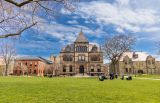Sierra Nevada Corp. Dream Chaser Mini Space Shuttle Landing Gear Fails in Test Flight, Crash Ensues
ByThe Dream Chaser mini space shuttle went out for a free-flying atmospheric test flight, but sustained damage on the landing when its equipment failed, NBC News reported.
Sierra Nevada Corp. unmanned prototype shuttle's damage has yet to be fully assessed, but it is reportedly fixable. The crash landing came after the Dream Chaser's landing gear failed to deploy at the Edwards Air Force Base in California.
Sierra Nevada is one of multiple private companies receiving funding from NASA to develop a spacecraft to make trips to the International Space Station (ISS). NASA has given the Dream Chaser Project $227.5 million thus far to build a spacecraft to bring astronauts to the ISS.
Saturday's test flight was a large step for Sierra Nevada's prototype. The Dream Chaser had only previously flown on "captive carry aerial tests," essentially hanging on a wire while another craft carried it through the air.
Immediate reactions to the crash were not promising, but NASASpaceFlight.com later eased those concerns by saying the damage would be fixable. The craft supposedly flipped over on the runway, but one commentator said a "pilot would have walked away" from the wreckage.
The day of the crash, Sierra Nevada released a statement, detailing the events of the test flight.
Today, Sierra Nevada Corporation (SNC) performed its first free-flight approach-and-landing test of the Dream Chaser spacecraft. The vehicle successfully released from its carrier aircraft, an Erickson Air-Crane helicopter, as planned at approximately 11:10 a.m. Pacific Standard Time. Following release, the Dream Chaser spacecraft automated flight control system gently steered the vehicle to its intended glide slope. The vehicle adhered to the design flight trajectory throughout the flight profile. Less than a minute later, Dream Chaser smoothly flared and touched down on Edwards Air Force Base's Runway 22L right on centerline. While there was an anomaly with the left landing gear deployment, the high-quality flight and telemetry data throughout all phases of the approach-and-landing test will allow SNC teams to continue to refine their spacecraft design. SNC and NASA Dryden are currently reviewing the data. As with any space flight test program, there will be anomalies that we can learn from, allowing us to improve our vehicle and accelerate our rate of progress. Please continue to monitor, www.SNCDreamChaser.com, for more information.
© 2025 University Herald, All rights reserved. Do not reproduce without permission.








